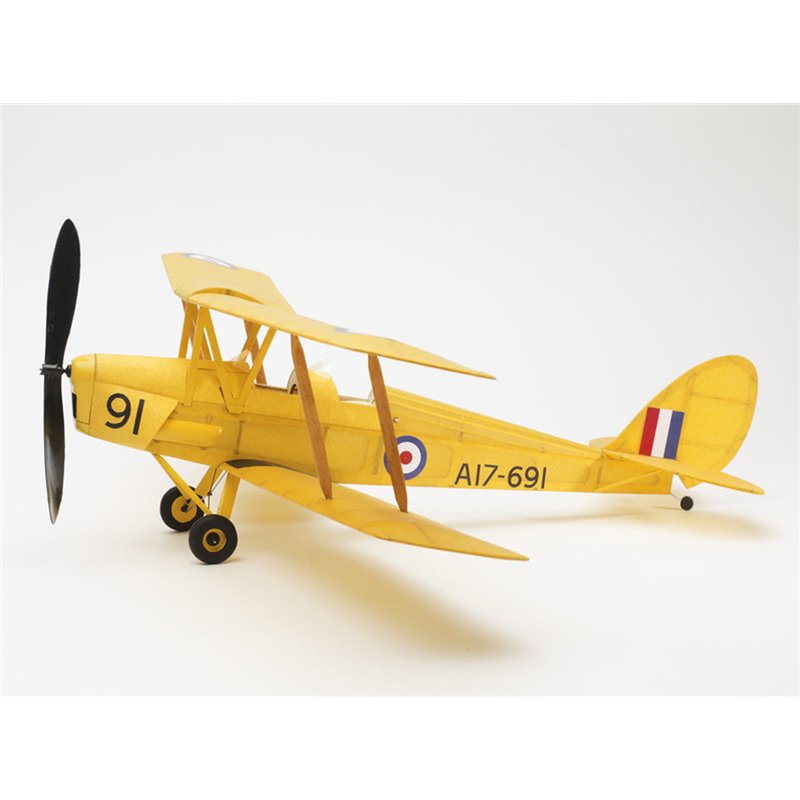






RC MODEL STORE The Fastest growing name in Radio Control
RC MODEL STORE The Fastest growing name in Radio Control
In the early 1930s the British Air Ministry issued a specification for a new trainer aircraft for the RAF. The RAF themselves were quite keen on the DH.60 Gypsy Moth due to its excellent handling characteristics and low running costs, but it fell short of the specification due to the position of the wings relative to the front cockpit which did not allow the pilot to easily bail out.
Determined to win the order, de Havilland took a Gypsy Moth aside and had the top wings moved forward to meet the specification. However, this resulted in the balance of the aircraft being affected, so both sets of wings were swept back and when that wasn't quite enough, the top wings were swept back a little further.
It then became clear that the sweep had reduced the ground clearance of the lower wings and so the inter-plane struts were shortened and the dihedral of the bottom wing increased.
Whether by accident or design, all of these changes made the DH.82 Tiger Moth an excellent training aircraft - often summarised by the phrase "easy to
fly, but difficult to fly well". This meant that it was safe in the hands of a novice but helped instructors weed out weaker pilots.
The RAF began using the aircraft in 1932 and it was not replaced until 1952, meaning the vast majority of RAF and Commonwealth pilots that served in the Second World War, first took to the air in a Tiger Moth.
Nearly 9000 Tiger Moths were built and many were sold as surplus after the war with the result that a great number survive to this day in the hands of pleasure flight companies and within a community of dedicated enthusiasts.
This kit is designed for you to build a traditionally constructed, rubber powered, free flight model of a DH.82A Tiger Moth.
The kit includes the materials (other than paints) to complete the suggested authentic scheme of a yellow Royal Australian Air Force Tiger Moth. This is a simple but striking scheme, but you can decide to do your own favourite or more complicated scheme if you wish.
This particular aircraft was privately imported into Australia in 1936 and pressed into service for the RAAF at the Temora Elementary Flying Training
School in 1940. Having left service after the war, it was eventually donated to the Temora Aviation museum where it is now based.
Construction of the model from this kit uses the traditional method of "stick and tissue", that consists of a built up balsa wood skeleton (framework), covered with a tissue skin. The balsa frameworks are built over a plan that is printed at the exact scale of the model, which is in essence a real engineering drawing.
Power is provided by rubber strip motor that is wound up before flight. Free flight means just that - once the model is launched, it is on its own. It must follow a predetermined flight path established when the model is initially adjusted for flight or "trimmed".
This type of traditional building technique and flying requires a degree of patience and skill, but is extremely rewarding.
Typically for a small model and in the spirit of the traditional kits, profiles are simplified and adjusted from the original and a relatively large propeller is used. This is done so that the model is light and stable enough to fly on its own, is simple in construction and can work with the rubber motor.
These adjustments have been done with care and sensitivity so that the shape and spirit of the original aircraft is preserved as much as possible.
Also in the spirit of the traditional kits, additional items required to build the model are things that can be found in the kitchen drawer or are easily available on the high street.
Four balsa sheets with precise laser cut parts and strip wood.
PVA glue for building the wooden frames.
One 150mm diameter plastic propeller.
One pre-bent motor hook and shaft.
Small piece of acetate sheet for the screens
Three low friction plastic nose bushings - one for the propeller and two for the undercarriage wheels.
Piano wire for the main undercarriage and tail wheel legs.
One motor peg (cocktail stick or toothpick).
Rubber motor strip.
Tissue to cover the model.
Parts reference sheets (W), full size summary plan sheets (X), scheme diagram sheet (Y) and scheme markings (Z) printed on lightweight paper.
The grey and yellow model was built, decorated and photographed by Kenneth Robinson
No customer reviews for the moment.